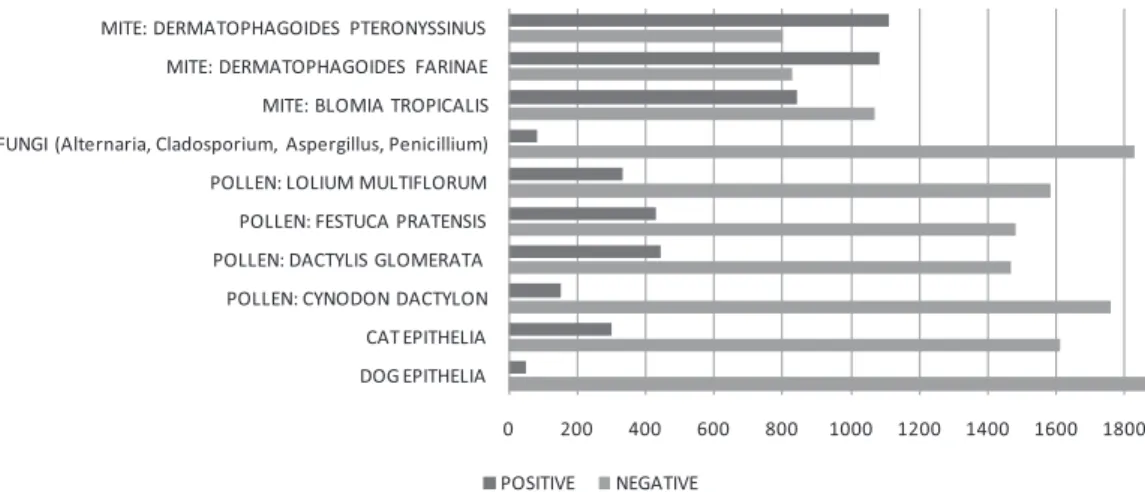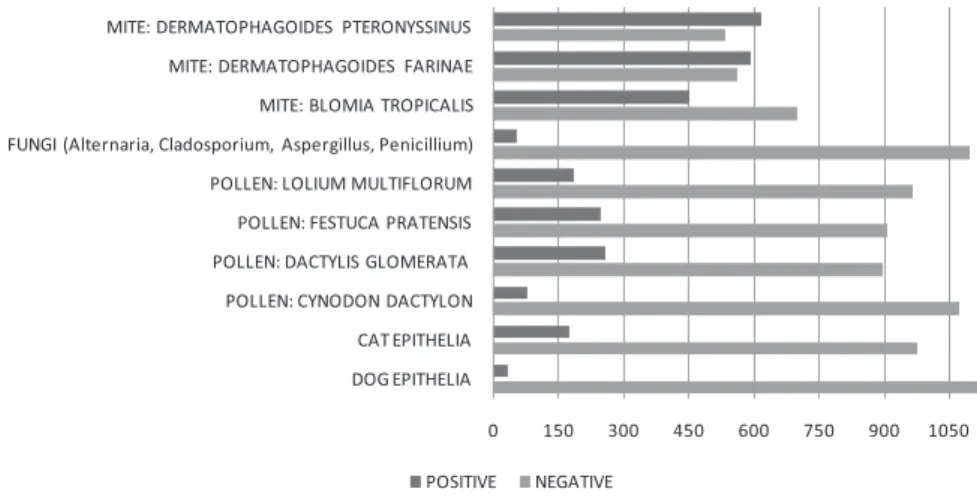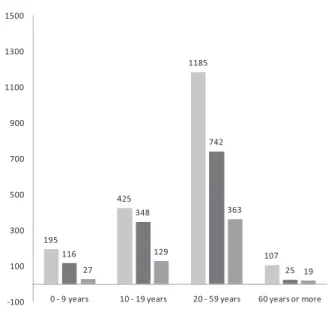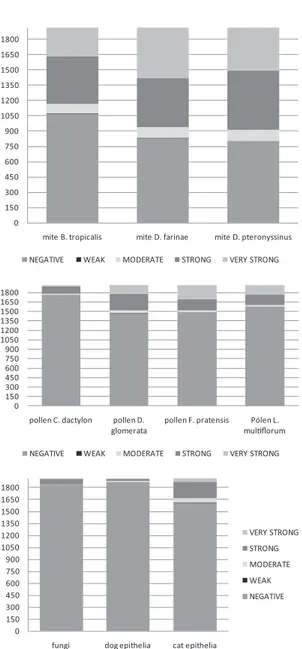Sensitization Pro
fi
le to Allergens in Patients
Using Multi-Test II
Sergio Fabricio Maniglia
1Fernanda Miyoko Tsuru
2Victor Carvalho dos Santos
2Denis Massatsugu Ueda
31Centro de Rinite e Alergia, Instituto Paranaense de Otorrinolaringologia, Curitiba, Brazil
2Faculdade Evangélica do Paraná, Curitiba, Brazil 3Universidade Federal do Paraná, Curitiba, Brazil
Int Arch Otorhinolaryngol 2014;18:391–397.
Address for correspondence Fernanda Miyoko Tsuru, MD, Faculdade Evangélica do Paraná, Rua Angelo Sampaio, 1190, Curitiba 80420160, Brazil (e-mail: feu.tsuru@yahoo.com.br).
Introduction
The increased prevalence of atopic diseases in all age groups is noted in the literature.1 According to the World Health Organization (WHO), 35% of the world popu-lation has some type of allergy, the same tendency as in Brazil.2
Medical intervention in allergies has broadened its per-spective, also focusing on the interference of atopy in the quality of life of patients. Impairments in sleep–wake cycle and low academic and occupational performance are among the most prevalent complaints, which raise the importance of proper intervention.3–5
As a principle in allergy treatment, before using pharma-cotherapy, patients are instructed to avoid exposure to the causal agent. However, this makes it necessary to study the patient’s environment.
The analysis of allergens in different locations in Brazil shows a difference between thefindings, with varying tem-peratures and humidities, on indoor microclimate and exter-nal conditions.3,6Studies conducted in the middle Brazilian region showed a high prevalence of the mite Dermatopha-goides farinae,4,5 and in some coastal regions there is a preponderance of Dermatophagoides pteronyssinus.7–9 In
both regions, house dust mites are quite prevalent.
Keywords
►
hypersensitivity
►
allergens
►
environment
►
skin tests
Abstract
Introduction
Medical intervention in allergies has broadened its perspective, also
focusing in the quality of life of patients. Patients are instructed, before using
pharmacotherapy agents, to avoid the causal agent.
Objective
This study aims to analyze the sensitization pro
fi
le of patients with allergic
complaints and identify possible characteristics speci
fi
c to each age group and gender.
Methods
A descriptive cross-sectional study included data collected from medical
records (from Multi-Test II database, Lincoln Diagnostics Inc. Decatur, Illinois) of 1,912
patients who underwent skin prick test from March to October 2013. Patients were
organized and analyzed according to gender, age, and results of the allergens subtypes
tested.
Results
The study was composed of 1,912 patients (60% male and 40% female) of ages
between 3 and 87 years. Positive tests were more prevalent in quantity and intensity
with the mites
Dermatophagoides pteronyssinus
and
Dermatophagoides farinae
, each with
60% of the total analyzed. In second place were pollens, especially
Dactylis glomerata
and
Festuca pratensis
.
Conclusion
The female and male sexes were equally atopic. Fungi and epithelia of dog
and cat were not considered potential aeroallergens that could cause symptoms.
However, mites are common in Paraná, Brazil. Further studies regarding the pollens are
needed, as this study result diverged from the literature.
received May 28, 2014
accepted after revision June 21, 2014 published online August 25, 2014
DOI http://dx.doi.org/ 10.1055/s-0034-1385845. ISSN 1809-9777.
Copyright © 2014 by Thieme Publicações Ltda, Rio de Janeiro, Brazil
Beyond these two species of mites, Dutra et al identified and related major aeroallergens of our environment, includ-ing other house dust mites of the genusBlomia, pollens of
Lolium multiflorumspecies, spores of fungi (Aspergillus, Peni-cillium, Alternaria), cockroach and animal epithelia.9
As an additional tool for both the physician and the patient, specific knowledge of the etiology of allergy has great value. The identification of specific allergen is performed by prick tests with an application of a drop containing the allergen in the patient’s forearm, then piercing the skin surface with an appropriate needle.10 A positive test is observed when a wheal greater than or equal to the application wheal of the positive control is formed (histamine 10 mg/mL).
Thus, given the large number and the immense variety of allergens in Curitiba-PR and metropolitan area, as well as individual reaction to each allergen, an allergic profile of this population would be beneficial. This will enable physicians to better guide their patients with environmental control measures.
The present study aims to analyze the sensitization profile of patients of Center Rhinitis and Allergy from Hospital X (specializing in otolaryngology) at Curitiba-PR with allergic complaints and identify possible specific characteristics of each age group and gender.
Methods
This descriptive cross-sectional study collected data from medical records from Multi-Test II (Lincoln Diagnostics Inc. Decatur, Illinois) and Hospital X databases. An ethical commit-tee from Hospital Paranaense de Otorrinolaringologia Ltda.– IPO (Instituto Paranaense de Otorrinolaringologia) approved this study on July 2013 under protocol number 366697. The study population (a total of 1,912 patients) included those who had skin testing (i.e., initial consultation) and all who had complaints or symptoms of allergic rhinitis: sneezing, abun-dant clear rhinorrhea, nasal obstruction, and intense nasal itching.11
The study was conducted in three phases. Atfirst, patients were identified through the Multi-Test II database and the results of skin tests were recorded. Then, for the collection of
personal data (age and gender), the Hospital X database was searched. Finally, patients were selected and analyzed with a database constructed by the authors.
Inclusion criteria were patients who underwent cutaneous prick test from Multi-Test II (multiheaded devices) from March 14 to October 4, 2013, in Hospital X, Paraná, Brazil. Patients were selected to reduce possible measurement bias, because the puncture mechanism differs between all the other brands on the market. Exclusion criteria were patients with incomplete and/or duplicate records and those whose allergy test identified prior use of antihistamine or presence of dermatographism.
Skin was tested for allergenic extracts of fungi (Aspergillus, Penicillium, Alternaria,andCladosporium), pollen (Cynodon dactylon[common grass],Dactylis glomerata[Rhodes grass],
Festuca pratensis[and meadow fescue],L. multiflorum [rye-grass]), mites (Blomia tropicalis, D. farinae, D. pteronyssinus), and animal epithelia (dog and cat). All extracts were made by the same industry Immunotec/FDA Allergenic from Rio de Janeiro, Brazil. The variables in these tests were positive or negative response, wheal size, and presence or absence of pseudopodia.
Papule size formed after exposure to the allergen was
classified as negative (0 to 2 mm), weak (3 to 4 mm),
moderate (5 to 6 mm), strong (7 to 9 mm), or very strong (greater than or equal to 10 or presence of pseudopodia).
Patients were grouped according to age, based on the WHO definition: children (0 to 9 years), adolescents (10 to 19 years), adults (20 to 59 years), and elderly (60 or more).
Table 1 Distribution of patients by age group
Age group Middle age (y) Total (%)
Children (9 y) 7 195 (10.2%)
Teenagers (10–19 y) 14.5 425 (22.2%)
Adults (20–59 y) 33.5 1185 (62%)
Elderly (60 y) 67 107 (5.6%)
Sample: 3–87 y 28.5 1912 (100%)
0 200 400 600 800 1000 1200 1400 1600 1800 DOG EPITHELIA
CAT EPITHELIA POLLEN: CYNODON DACTYLON POLLEN: DACTYLIS GLOMERATA POLLEN: FESTUCA PRATENSIS POLLEN: LOLIUM MULTIFLORUM FUNGI (Alternaria, Cladosporium, Aspergillus, Penicillium) MITE: BLOMIA TROPICALIS MITE: DERMATOPHAGOIDES FARINAE MITE: DERMATOPHAGOIDES PTERONYSSINUS
POSITIVE NEGATIVE
All data were organized into spreadsheets in Microsoft Office Excel 2007 (Microsoft Corp., Redmond, Washington, United States) according to age, gender, type of allergen, and skin test result and subsequently analyzed.
Results
We analyzed 2,132 charts of patients with previous allergic complaints who underwent skin prick test with Multi-Test II from March 14 to October 4, 2013, in Hospital X, Paraná, Brazil. However, only 1,912 met the inclusion criteria of the study. The other 220 patients were excluded for the following reasons: presence of dermatographism, previous use of anti-histamine, incomplete records, and duplicated tests (one case of duplicated test was included, the latest one).
Thefinal sample of patients contained both sexes, with60% male (1,151) and 40% female (761). Ages ranged from 3 to 87 years, with an overall average age of 28.5 years (►Table 1).
Tests were performed with four types of aeroallergens: dust mites (D. pteronyssinus, D. farinae, B. tropicalis), fungi (unique blend of Alternaria, Cladosporium, Aspergillus,and
Penicillium), pollen (C. dactylon, D. glomerata, F. pratensis,and
L. multiflorum), and animal epithelia (dog and cat). A total of
10 types of allergenic extracts were performed in 1,912 patients.
The wheal size of the positive control did not exceed 10 mm and the minimum extent observed among children, adolescents, adults, and the elderly were, respectively, 4, 6, 5, and 7 mm. All negative controls had 0 mm.
Regardless of gender and/or age, tests of 1,360 patients (71%) were positive for at least one type of allergen. Among them, the main etiologic agents of atopy were mostly mitesD. pteronyssinus and D. farinae, each with 60% of the total analyzed. A smaller allergic response was obtained with dog epithelia and fungi extract, with values below 5% (►Fig. 1).
0 150 300 450 600 750 900 1050
DOG EPITHELIA CAT EPITHELIA POLLEN: CYNODON DACTYLON POLLEN: DACTYLIS GLOMERATA POLLEN: FESTUCA PRATENSIS POLLEN: LOLIUM MULTIFLORUM FUNGI (Alternaria, Cladosporium, Aspergillus, Penicillium) MITE: BLOMIA TROPICALIS MITE: DERMATOPHAGOIDES FARINAE MITE: DERMATOPHAGOIDES PTERONYSSINUS
POSITIVE NEGATIVE
Fig. 2 Results of allergy tests performed according to the type of allergen extracts used in female patients (total¼1,151).
0 100 200 300 400 500 600 700 800
DOG EPITHELIA CAT EPITHELIA POLLEN: CYNODON DACTYLON POLLEN: DACTYLIS GLOMERATA POLLEN: FESTUCA PRATENSIS POLLEN: LOLIUM MULTIFLORUM FUNGI (Alternaria, Cladosporium, Aspergillus, Penicillium) MITE: BLOMIA TROPICALIS MITE: DERMATOPHAGOIDES FARINAE MITE: DERMATOPHAGOIDES PTERONYSSINUS
POSITIVE NEGATIVE
Fig. 3 Results of allergy tests performed according to the type of allergen extracts used in male patients (total¼761).
Table 2 Number of positive results for one or more allergens according to age
0–9 y 10–19 y 20–59 y >59 y
Total of tests
195 425 1185 107
Positives 119 (61%)
363 (85.5%)
841 (71%)
Also, 64.4% of patients (1231) showed sensitivity to at least one species of mite tested, 4.3% (82) to fungi, 28.1% (538) to one or more kinds of pollen, and 17.3% (330) to animal epithelia. In the study, only one patient was sensitive to all inhalant allergens tested.
In females (total¼1,151), 67% had a positive allergy test for any statement, and in males (total¼761), 77.4%. The proportion of responses to allergens followed a very similar pattern between sexes and when compared with the total group: increased prevalence of sensitivity to mites and fungi and the lower dog epithelia (►Figs. 2and3).
Groups were divided by age. From 0 to 9 years, 119 (61%) were susceptible to at least one type of allergen, and of these, 97% were sensitive to one of three types of mite. From
10 to 19 years, 363 (85.5%) showed positive results to one or more statements. Following the same analysis criteria, 841 (71%) were positive in the range of 20 to 59 years, and 37 (34.5%) were also positive in the sample above 59 years old. The mites were responsible for most of positive results, especially among teenagers. Next were the pollens, with similar quantities in adults and adolescents (►Table 2
and►Fig. 4).
D. pteronyssinuswas the most prevalent mite in all age groups.D. glomerataandF. pratensiswere the most prevalent pollens. Both children and adolescents showed higher positiv-ity to cat extract than other animals: 26.15% (►Figs. 5and6).
The highest sensitivity was observed with mites, reaching levels close to 50% for each type. Fungi and dog epithelia showed fewer positive results.
Mites had strong (wheal 6 to 10 mm) and very strong (wheal equal or over 10 mm) predominant reactions. Among pollens,D. glomerata(60% positive) showed strong reaction andF. pratensis,very strong (50% positive). Tests with epithe-lia showed 15.7% positivity for cat subtype, predominantly papules with strong reaction, and only 2.5% for subtype dog (►Fig. 7).
Papules varied in size in positive tests. The minimum recorded was 4 mm (upper limit of mild rating) for all allergens except forP. multiflorum (pollen). The maximum size ranged according to the types of allergens: mites and pollens had larger sizes (15 to 16 mm) and fungi and epithelia, smaller (►Table 3).
The intensity of the reaction was also different between age groups irrespective of the allergen. The group of seniors had papules of small sizes, albeit in very strong reactions (►Table 4).
Pseudopodia, indicating strong sensitivity to allergens, was present in both genders and in all age groups, with the vast majority (99%) showing wheals of 10 mm. Pseudopodia by itself were not detected in the following groups: females, children and the elderly, using dog epithelia extract; elderly,
195
425
1185
107 116
348
742
25 27
129
363
19
-100 100 300 500 700 900 1100 1300 1500
0 - 9 years 10 - 19 years 20 - 59 years 60 years or more
TOTAL OF TESTS MITES POLLENS
Fig. 4 Positive results considering the two most prevalent allergen classes and the total in each age group.
0 15 30 45 60 75 90 105 120 135 150 165 180 195
0 25 50 75 100 125 150 175 200 225 250 275 300 325 350 375 400 425
B A
DOG EPITHELIACA T EPITHELIA DOG EPITHELIACA
T EPITHELIA
using cat dander; and in all age groups except adults when fungi extract.
Discussion
Currently the most practical method to verify the individual’s sensitivity to some allergen is through the prick test. The Multi-Test II was chosen because it allows simultaneous application of eight allergenic extracts, guaranteeing lower divergence between the amounts administered. We chose only the prevalent aeroallergens in Curitiba, Paraná, Brazil and metropolitan region,9because food allergy is commonly known by the patients themselves.
The literature shows no influence of sex on the prevalence of atopic diseases, which was also shown in this study.
This study revealed that 71% of patients were positive for at least one of the extracts used, being mostly mites, followed by pollens. The results are close to those obtained by Soares et al,12at 73.5%, and the 67.5% by Feld et al,13even though those studies were performed in other states, which is explained by the fact that studies tend to be done in areas in which aeroallergens are present.
Castro foundD. pteronyssinus, D. farinae,andB tropicalis,14 all belonging to the group of mites, to be the key antigens found in immunoallergic tests in patients with respiratory allergy. It is clear that in fact these three species also have high prevalence in this study, which corroborates another study by Dutra et al, in the city of Curitiba.9
The grassL. multiflorumis the most widespread in the city of Curitiba and nearby. Pollination occurs from September to December, the period of this study, and causes the most intense reactions to skin tests compared with other species.15 However, our results showing the pollen speciesD. glomerata
and F. pratensisclaiming more reactions in all age groups diverge from results in the literature.
Although the Curitiba climate has a high relative humidity throughout the year, fungi do not have a high impact. The
0 95 190 285 380 475 570 665 760 855 950 1045 1140
0 5 10 15 20 25
B A
Fig. 6 (A) Positivity of tests in relation to dust mites and pollens in (A) adults (total¼1,185) and (B) elderly (total¼107).
0 150 300 450 600 750 900 1050 1200 1350 1500 1650 1800
mite B. tropicalis mite D. farinae mite D. pteronyssinus
NEGATIVE WEAK MODERATE STRONG VERY STRONG
0 150 300 450 600 750 900 1050 1200 1350 1500 1650 1800
pollen C. dactylon pollen D. glomerata
pollen F. pratensis Pólen L. mulflorum
NEGATIVE WEAK MODERATE STRONG VERY STRONG
0 150 300 450 600 750 900 1050 1200 1350 1500 1650 1800
fungi dog epithelia cat epithelia
VERY STRONG STRONG MODERATE WEAK NEGATIVE
extract used showed low prevalence of positive tests, around 4.5% of 1,912 tests. In Brazil the prevalence varies from 2.2 to 33%.16
The study showed a very low sensitivity to animal epithe-lia, 17.3%, yet the positive response was greater with cat dander extract. A similar result was seen by Vieira et al.17In Brazilian regions within the age group of 3 to 16 years, Rizzo et al in their study found 3.1% positive for dog epithelia and the same percentage for cats,2values that were not similar when restricted to the region of our study: 1.7% and 26.15%, respectively.
The assessment of the presence or absence of pseudopodia is always made in skin tests, but it is almost nonexistent in the literature.
The present study examined the formation of these irreg-ularities in papules in all age groups and both genders, which may rule out the influence of these factors. However, extracts of animal epithelia in specific age groups, especially children and the elderly, have not revealed scaly papules. According to the III Brazilian Consensus on Rhinitis 2012,11the major cat allergen is produced by sebaceous glands and secreted by the skin, similar to dogs but with less allergenic component. There is evidence that exposure to household animals at an earlier stage of life before the occurrence of awareness can have a protective effect on atopic sensitization and allergic manifestations.
Conclusion
Sensitivity to aeroallergens depends on multiple factors, including the micro- and macroenvironment in which the individual is exposed. Males and females are both atopic, with no increased predisposition of some specific aeroallergen. Likewise, sex does not interfere with response antigen intensity.
Among the most prevalent aeroallergens in the region of this study, the genusDermatophagoideshas also been present in most similar studies. Research involving other types of pollens, other than theLoliumgenus, are needed, because different species predominated in this study. Fungi and ani-mal epithelia were not considered aeroallergens with a great potential to cause symptoms, which differs from common sense and would indicate redirection of prophylactic meas-ures in the intervention of allergies.
References
1 Burney PGJ. Epidemiologic trends. In: Barnes PJ, Grunstein MM, Leff AR, Woolcock AJ, eds. Asthma. Philadelphia, PA: Lippincott-Raven; 1997:35–47
2 Rizzo MCFV, Solé D, Rizzo A, et al. Atopic disease in Brazilian children eiologic multicentric study. J Pediatr (Rio J) 1995;71(1): 31–35
3 Graudenz GS, Kalil J, Latorre MR, Arruda LK, Gambale W, Morato-Castro FF. Exposição alergênica e sintomas respiratórios em ambientes climatizados. Rev Bras Alerg Imunopatol 2004; 27:94–102
4 Terra SA, Silva DA, Sopelete MC, Mendes J, Sung SJ, Taketomi EA. Mite allergen levels and acarologic analysis in house dust samples in Uberaba, Brazil. J Investig Allergol Clin Immunol 2004;14(3): 232–237
5 Sopelete MC, Silva DA, Arruda LK, Chapman MD, Taketomi EA. Dermatophagoides farinae (Der f 1) and Dermatophagoides pter-onyssinus (Der p 1) allergen exposure among subjects living in Uberlândia, Brazil. Int Arch Allergy Immunol 2000;122(4): 257–263
6 Justino CM, Segundo GR, Pereira FL, et al. Mite and pet allergen exposure in Brazilian private cars. Ann Allergy Asthma Immunol 2005;94(6):658–661
Table 3 Positive tests: variation in papule size according to the type of allergen
Allergens Minimum (mm) Maximum (mm) Middle (mm)
MiteBlomia tropicalis 4 15 8.4
MiteDermatophagoides farinae 4 15 9
MiteDermatophagoides pteronyssinus 4 15 8.7
Fungi 4 10 7
PollenCynodon dactylon 4 12 7.3
PollenDactylis glomerata 4 16 8.5
PollenFestuca pratensis 4 15 9.2
PollenLolium multiflorum 5 15 8.9
Dog epithelium 4 10 7
Cat epithelium 4 10 7.4
Table 4 Positive tests: variation in papule size according to age group
Age groups Minimum (mm) Maximum (mm)
Children 5–7 15
Teenagers 4–5 14–15
Adults 4 15–16
7 Arruda LK, Rizzo MC, Chapman MD, et al. Exposure and sensitiza-tion to dust mite allergens among asthmatic children in São Paulo, Brazil. Clin Exp Allergy 1991;21(4):433–439
8 Rullo VE, Rizzo MC, Arruda LK, Solé D, Naspitz CK. Daycare centers and schools as sources of exposure to mites, cockroach, and endotoxin in the city of São Paulo, Brazil. J Allergy Clin Immunol 2002;110(4):582–588
9 Dutra BM, Rosário Filho NA, Zavadniak AF. Alérgenos inaláveis em Curitiba: uma revisão de sua relevância clínica. Rev Bras Alerg Imunopatol. 2001;24:189–195
10 Godinho R, Lanza M, Godinho A, Rodrigues A, Assiz TM. Freqüência de positividade em teste cutâneo para aeroalérgenos. Rev Bras Alerg Imunopatol. 2003;69:824–828
11 Associação Brasileira de Otorrinolaringologia e Cirurgia Cér-vico-Facial. III Consenso Brasileiro sobre Rinites 2012. Braz J Otorhinolaryngol Nov/Dec 2012. Avaiable on: http://www. aborlccf.org.br/imageBank/CONSENSO_SOBRE_RINITE_-SP-2013-04.PDF
12 Soares FAA, Segundo GRS, Alves R, et al Perfil de sensibilização a alérgenos domiciliares em pacientes ambulatoriais. Rev Assoc Med
Bras [online] 2007;53(1):25–28. http://www.scielo.br/pdf/ramb/ v53n1/14.pdf
13 Feld L, Lima BC, Costa E. Sensibilização a alérgenos inaláveis em pacientes com alergia respiratória na cidade no Rio de Janeiro: comparação entre asma brônquica e rinite isolada. Rev Bras Alerg Imunopatol 2001;24:54–64
14 Castro FFM. Rinite Alérgica—Modernas Abordagens para uma Clás-sica Questão. 1ª. São Paulo, Brazil: Lemos Editorial e Gráficos; 1997 15 Esteves PC, Rosário Filho NA, Trippia SG, Caleffe LG. Prevalência de rinite alérgica perene e sazonal, com sensibilização atópica ao Dermatophagoides pteronyssinus (Dp) e ao Lolium multiflorum (LOLIUM) em escolares de 13 e 14 anos e adultos de Curitiba. Rev Bras Alergia Imunopatol 2000;23:249–259
16 Faria A. Preliminay study on mycotic anemophilous lora of Belo Hotizonte, Minas Gerais. I. Frequencey of the fungi genera of allergic interests. Rev Inst Med Trop Sao Paulo 1967;9(1):43–45 17 Vieira MC, Taranto P, Stangenhaus C, et al. Hipersensibilidade a




